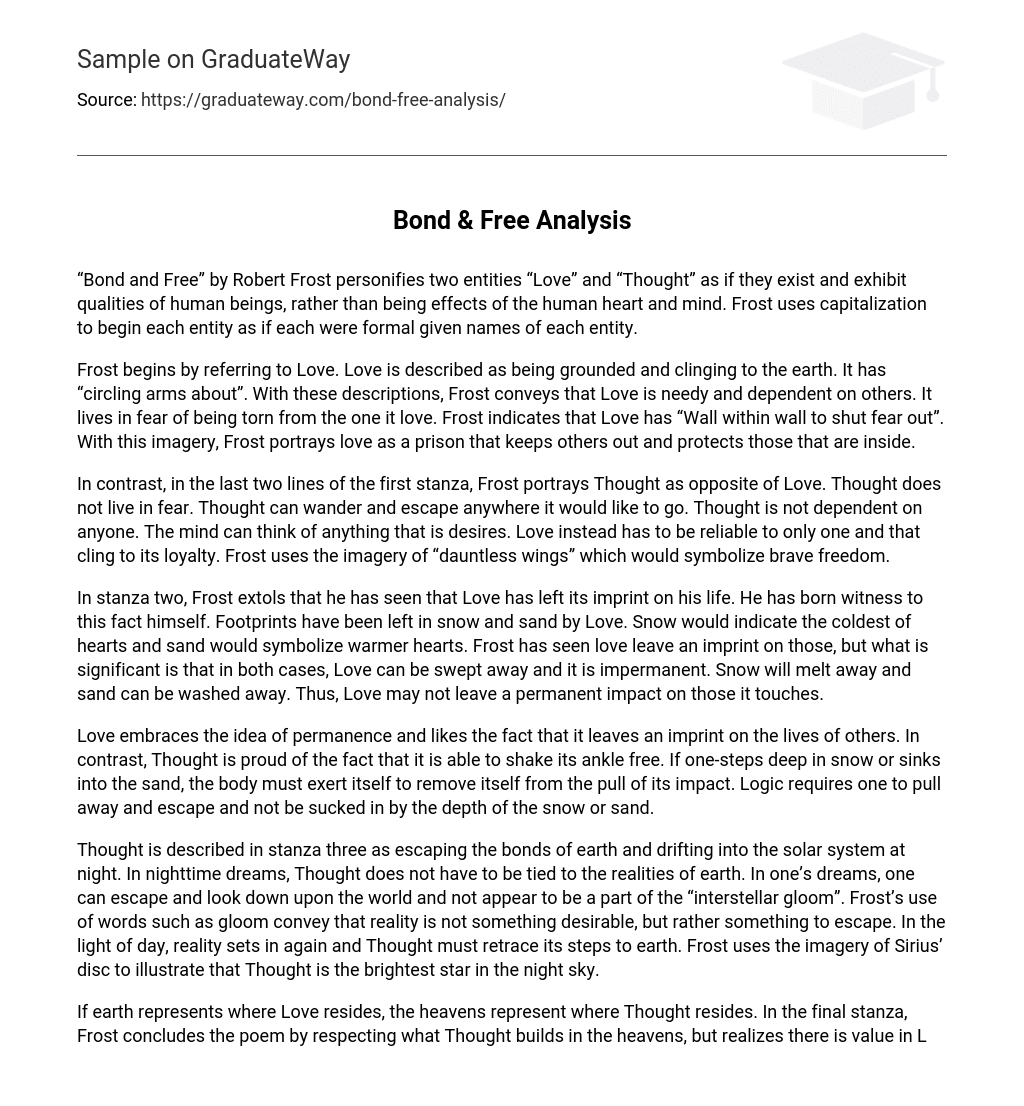“Bond and Free” by Robert Frost personifies two entities “Love” and “Thought” as if they exist and exhibit qualities of human beings, rather than being effects of the human heart and mind. Frost uses capitalization to begin each entity as if each were formal given names of each entity.
Frost begins by referring to Love. Love is described as being grounded and clinging to the earth. It has “circling arms about”. With these descriptions, Frost conveys that Love is needy and dependent on others. It lives in fear of being torn from the one it love. Frost indicates that Love has “Wall within wall to shut fear out”. With this imagery, Frost portrays love as a prison that keeps others out and protects those that are inside.
In contrast, in the last two lines of the first stanza, Frost portrays Thought as opposite of Love. Thought does not live in fear. Thought can wander and escape anywhere it would like to go. Thought is not dependent on anyone. The mind can think of anything that is desires. Love instead has to be reliable to only one and that cling to its loyalty. Frost uses the imagery of “dauntless wings” which would symbolize brave freedom.
In stanza two, Frost extols that he has seen that Love has left its imprint on his life. He has born witness to this fact himself. Footprints have been left in snow and sand by Love. Snow would indicate the coldest of hearts and sand would symbolize warmer hearts. Frost has seen love leave an imprint on those, but what is significant is that in both cases, Love can be swept away and it is impermanent. Snow will melt away and sand can be washed away. Thus, Love may not leave a permanent impact on those it touches.
Love embraces the idea of permanence and likes the fact that it leaves an imprint on the lives of others. In contrast, Thought is proud of the fact that it is able to shake its ankle free. If one-steps deep in snow or sinks into the sand, the body must exert itself to remove itself from the pull of its impact. Logic requires one to pull away and escape and not be sucked in by the depth of the snow or sand.
Thought is described in stanza three as escaping the bonds of earth and drifting into the solar system at night. In nighttime dreams, Thought does not have to be tied to the realities of earth. In one’s dreams, one can escape and look down upon the world and not appear to be a part of the “interstellar gloom”. Frost’s use of words such as gloom convey that reality is not something desirable, but rather something to escape. In the light of day, reality sets in again and Thought must retrace its steps to earth. Frost uses the imagery of Sirius’ disc to illustrate that Thought is the brightest star in the night sky.
If earth represents where Love resides, the heavens represent where Thought resides. In the final stanza, Frost concludes the poem by respecting what Thought builds in the heavens, but realizes there is value in Love as well.
Beginning in stanza three, Thought begins to be personified as male with the use of the pronouns him and his. This creates the juxtaposition of Love as being a female characterization. Symbolically then Frost is proposes men as being the logical thinkers, who long for escape from the entrapment of Love or the female figure. Females long to cling to the man and hold him too close. Most of the time men are searching for something else outside of the gloom of entrapment by a woman. In the concluding stanza, Frost then reveals that perhaps Love is “fused in another star”. This would indicate that Love might be its own adventure rather than something that ties a man to the more negative sides of the reality of life.
Frost incorporates several other poetic elements into the poem “Bond and Free” beginning with rhyme scheme. Each stanza has an ABBAA rhyme scheme. For example in stanza one clings, things, wings rhyme and about and out rhyme. Assonance appears regularly beginning in stanza one with the repetition of the short “I” sounds with words such as with, hills, and cling. In stanza two, assonance is evident in the long “A” sound in the words day, make and embrace.
Alliteration is evident in stanza one with the repeated “W” sounds such as “wall within wall”. In the last stanza Frost ends the poem with repetition of words beginning with the “F” sound such as fares, far, find, and fuse. The rhythm of the poem varies the line length from 7-9 syllables per line.
“Bond and Free” as a title choice reflects the choice that Frost sees in Thought and Love as well as men and women. Both men and women have the choice of whether or not they want to accept the bonds of Love or if they prefer the freedom of Thought instead.





